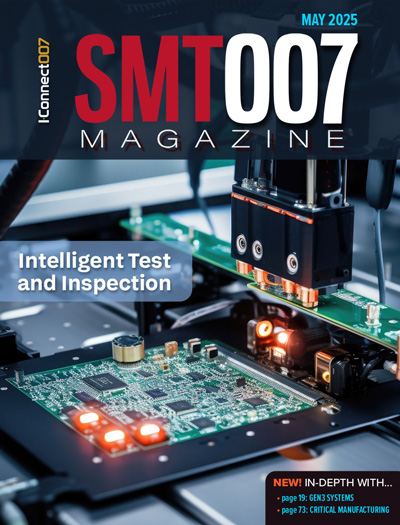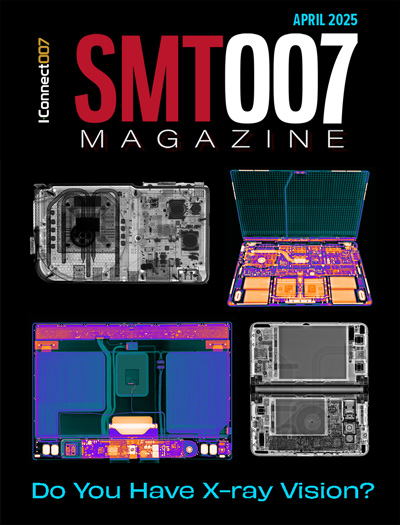-

- News
- Books
Featured Books
- smt007 Magazine
Latest Issues
Current Issue
Moving Forward With Confidence
In this issue, we focus on sales and quoting, workforce training, new IPC leadership in the U.S. and Canada, the effects of tariffs, CFX standards, and much more—all designed to provide perspective as you move through the cloud bank of today's shifting economic market.

Intelligent Test and Inspection
Are you ready to explore the cutting-edge advancements shaping the electronics manufacturing industry? The May 2025 issue of SMT007 Magazine is packed with insights, innovations, and expert perspectives that you won’t want to miss.

Do You Have X-ray Vision?
Has X-ray’s time finally come in electronics manufacturing? Join us in this issue of SMT007 Magazine, where we answer this question and others to bring more efficiency to your bottom line.
- Articles
- Columns
Search Console
- Links
- Media kit
||| MENU - smt007 Magazine
Estimated reading time: 2 minutes
American Made Advocacy: America, It’s Time to Reclaim Manufacturing Leadership
As an industry veteran of almost 35 years, I’ve witnessed the alarming contraction of America’s microelectronics ecosystem. At the turn of the century, America boasted more than 2,000 printed circuit board manufacturers. Today that number has fallen to less than 150.
Like other microelectronics we invented and perfected, PCB manufacturing was offshored to Asia, which undermined our ability to participate fully in the growing global PCB market. Our steady decline in global market share comes with an additional cost: U.S. PCB manufacturers are increasingly being left behind in adopting the latest equipment and process innovations that are being introduced in Asia. This gradual decoupling challenges our ability to evolve with commercial design trends and will cause further decline in global share if not addressed.
The dominance of PCB manufacturing we see in Asian countries is no accident and didn’t happen overnight. It is the result of focused industrial policy over decades. China, South Korea, Malaysia, and Vietnam provided significant government support and private investment followed.
Today as manufacturers explore a China Plus One strategy, countries like Thailand have followed others to add yet one more competitor in the world market.
America’s leaders have seen the threat of foreign dependency and begun to act, with a strong first step in the semiconductor arena. Once policymakers realized that 13% market share in semiconductors was a threat to our national and economic security, a bipartisan consensus emerged to break ground on chip fabs here at home.
Anyone flying into Phoenix recently could not miss the forest of construction cranes as new semiconductor fabs rise from the desert floor. What is conspicuously absent is concurrent work on the rest of the microelectronics ecosystem. If America can manufacture cutting-edge semiconductors, we can also make the next generation of printed circuit boards, IC substrates, and raw and refined materials.
When it comes to creating effective national industrial policy, there are many levers the government can pull to increase American manufacturing. At the moment we’re relying on tariffs. As the new administration implements these tariffs, our industry, like many others, is carefully monitoring the effects. When selectively applied, tariffs can be an effective tool to level the playing field.
However, tariffs can be changed or repealed by a single political appointee and, therefore, do not always incentivize long-term investment in domestic production.
There is more in the toolkit that Congress and federal agencies can use to promote domestic industry growth. Tax incentives and direct investment provide longer-term, structural benefits to U.S. producers. As we have seen in the case of semiconductor production, government support through the CHIPS Act attracted hundreds of billions of dollars in private investment alongside government money. What the PCB industry needs is the durable demand signal that will generate a stronger investment case for the domestic production of microelectronics. When it comes to Wall Street, Uncle Sam’s endorsement is second to none.
The investments being made in semiconductor manufacturing are an important first step but, as PCBAA has said since our founding, “Chips don’t float.” While the U.S. and other nations are investing in chip production, we find ourselves in a situation where we cannot provide the number of PCBs these American-made chips must be assembled to. Having staked our claim for semiconductor production, now is the time to build on that momentum and incentivize the rest of the technology stack and create the demand signal that will reverse decades of decline.
This column originally appeared in the April 2025 issue of PCB007 Magazine.
More Columns from American Made Advocacy
American Made Advocacy: Lobbying Congress Supports the Supply ChainAmerican Made Advocacy: Reshoring—About Trust, Not Just Geography
American Made Advocacy: Long-time Challenges Confront a New Administration
American Made Advocacy: New Congress, New Opportunities
American Made Advocacy: Success in Washington Requires Patience, Persistence, and Sustained Focus
American Made Advocacy: The Administration Changed, but Our Industry’s Needs Remain
American Made Advocacy: There's No Substitute for American-made Microelectronics
American Made Advocacy: Let’s Finish the Fight to Build and Buy American


